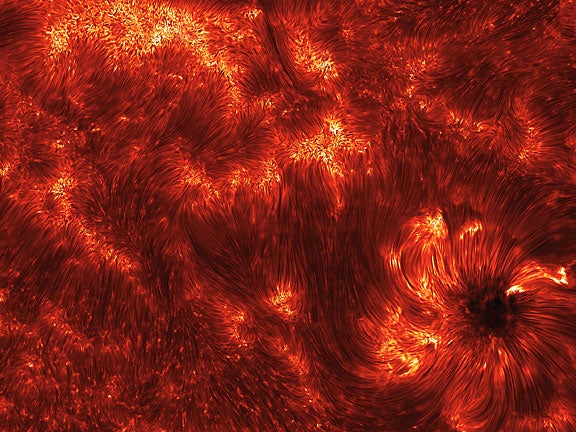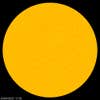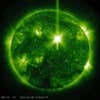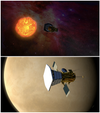Yesterday, the vernal equinox, the sun returned to the Northern Hemisphere at last. Nothing here or anywhere else in our corner of the galaxy would exist without the sun, yet a surprising number of solar mysteries persist. Much of heliophysics is focused on “space weather,” predicting what the sun will do. That’s because solar flares and coronal mass ejections spew charged particles and radiation into space, occasionally toward Earth. These seething bursts of energy can jeopardize telecommunications on the ground and in space, not to mention the lives of astronauts.
But there are plenty of other, perhaps more profound, burning questions: how does the star actually work? What’s inside it? What, exactly, it is belching out at us?
Check out our gallery of some burning questions about the sun.
Ephraim Fischbach, a physics professor at Purdue University, is trying to figure out whether solar particles are messing with radioactive materials on Earth, for instance. Something is definitely happening; it’s just that no one can explain it yet.
New spacecraft like the Solar Dynamics Observatory could help answer some of these questions.
“We’re moving toward a weather-type analysis, what has to happen inside the sun to see what will happen outside the sun. If we get a model for that, we need to test it, and that’s the data the satellites are giving us,” said W. Dean Pesnell, project scientist for the Solar Dynamics Observatory at NASA’s Goddard Space Flight Center. “We are asking people to give us a far more detailed analysis of the sun than other stars or planets.”
In celebration of the sun’s return to the northern hemisphere — and NASA’s Solar Week festivities — here we take a look at some major questions scientists still have about the sun, and the ways new spacecraft are helping answer them.
How Does the Sun Lose Its Spots?
Earlier this month, NASA announced scientists had finally figured out why sunspots disappear, which has mystified scientists for at least 200 years. It has to do with the sun’s insides, which are churning around much like ocean currents on the Earth. For most of 2008 and part of 2009, the solar disk was blemish-free, which hadn’t happened since 1913, and before that, 1810. It was during the last solar minimum, a period of decreased activity in each 11-year solar cycle. But things were a little quieter than usual. What’s more, the sun’s magnetic field weakened, which allowed cosmic rays to run rampant in the solar system, and Earth’s upper atmosphere cooled off and collapsed. The culprit was plasma currents within the sun that interfered with the production of sunspots, scientists said in a paper published March 3. These so-called meridional flows act as a great conveyor belt, sweeping along the sun’s surface, plunging deep inside at the poles and emerging again near the equator. Sunspots are highly magnetized areas of plasma on the sun’s surface, and like anything else, they have a lifespan. When they start to die and de-magnetize, the conveyor belt sweeps them away and drags the plasma into the heart of the sun, where the sun’s magnetic “dynamo” (the name for the mechanism that creates the sun’s magnetic field) recharges them. Then they reappear. But in 2008, the sunspot reincarnation wasn’t happening. Scientists think it was because back in the late 1990s, the plasma currents had been moving too fast for the dynamo to do its job, and the sunspots couldn’t be recharged. Even after the currents sped up again in the early 2000s, there weren’t enough sunspots to recharge. The result was the deepest solar minimum in a century, and it led to a late start for Solar Cycle 24, which began in early 2010. New models help explain how all this happened, said study co-author Dibyendu Nandi, an assistant professor at the Indian Institute of Science Education and Research in Kolkata, India. “It opens up possibility of predicting extreme solar behavior like deep minima, such as what we witnessed, based on internal flows,” he said.
Why Is Its Atmosphere Hotter Than Its Surface?
It’s a long-standing mystery of physics: “You don’t expect a star that’s hot in the middle to get hotter as it goes away from the surface,” said NASA project scientist Joe Gurman, who works on the Solar TErrestrial RElations Observatory (STEREO) mission. But somehow the sun’s surface, around 11,000 degrees, is cool compared to the superheated corona, which reaches millions of degrees. What brings this extra warmth to the sun’s atmosphere? In January, scientists said they may have an answer: Plasma fountains called spicules, like those seen here, that shoot up from the chromosphere. That’s an area just above the sun’s surface. The plasma fountains are as long as Earth and last a few minutes, but a newly observed class of spicules lasts about 100 seconds, moving 186,000 miles per hour. The Solar Dynamics Observatory and the Japanese Hinode spacecraft (meaning “dawn”) were able to catch them in action. Scientists at Lockheed Martin’s Advanced Technology Center, the National Center for Atmospheric Research and the University of Oslo, Norway, published a paper on the spicules in the journal Science. They found that the heated spicules likely occur often enough to continuously replenish the corona, but there are still plenty of questions — the interface between the surface and the corona is still pretty poorly understood. An upcoming NASA mission scheduled for launch next year will provide some answers (keep reading to find out more).
Is the Sun Spewing Mystery Particles?
Ephraim Fischbach knows some people probably think he’s crazy. But according to his data, and that of other unrelated teams around the world, there’s no mistaking it: solar particles are messing with radioactive elements on Earth. Last year, we told you how Fischbach and his colleagues at Purdue University noticed a change in the radioactive decay rate of a manganese isotope, and tied it to a solar flare. They determined that something came out of the sun, traveled through the Earth, hit a piece of manganese-54 and changed the rate at which it emitted ionizing particles. They have since been checking other radioisotope data and the pattern is clear, Fischbach said. “It becomes very difficult to avoid the conclusion that we’re seeing something new,” he said. “There is no explanation at the present that can account for it, other than something of unknown origin.” It gets better: They also realized the Dec. 13 anomaly started a day and a half before the flare. So whatever is messing with radioactive decay is also apparently a harbinger of some major solar activity. The most reasonable explanation is solar neutrinos, but these are essentially massless and do not interact with normal matter — which is why they can travel through the planet in the first place. So it’s still a mystery. In a happy coincidence, the Messenger spacecraft, currently orbiting Mercury, might be able to provide some answers. After hearing about Fischbach’s work, some Messenger scientists contacted him to let him know someone had accidentally left a piece of cesium-137 on the spacecraft. It’s a common element used to calibrate various science instruments. It could also provide an up-close test of the decay anomaly — as Messenger gets close to the sun, scientists will check whether it affects the cesium’s decay rate, “just serendipitously because someone made a mistake,” Fischbach said. He just submitted a paper on it. “We think something is cooking underneath the surface of the sun, and that cooking produces more or fewer neutrinos, whatever it is, but it changes the rate of the neutrinos coming out. The electromagnetic radiation would follow later,” Fischbach added. “We believe you get a precursor signal because we are seeing something which is coming out earlier.” At the time of the flare, astronauts were on a spacewalk at the International Space Station, Fischbach said. They were fine, but it punctuated the importance of predicting solar events. “If they are running around on the moon and a solar flare comes, they would be toast,” he said. “But now if we see a precursor signal, we could warn them a day or so before.”
Can 3-D Views and Solar X-Rays Explain the Origin of Solar Flares?
The sunspot reincarnation theory mentioned earlier might be a triumph of computer models, but a fleet of sun-observing spacecraft will be able to prove it right or wrong. Solar flares and coronal mass ejections (CMEs) are the holy grail of sun research — scientists want to be able to predict when they’ll happen, but central to that ability is a deeper understanding of how they are produced. NASA’s Solar Dynamics Observatory will help scientists study the life cycle of the sun’s magnetic field, which will explain the genesis of flares and CMEs, said Dean Pesnell, project scientist for SDO. “Solar flares are times when the sun has taken the magnetic field and converted it into heat. A CME is when the sun takes the magnetic field and just throws it away,” he said. “What causes the flare must be something where the magnetic field is there, it’s happy, and then it gets pushed up too much, and crinkled up too much, and it turns into heat. The final part that cannot do that is thrown off as a CME. We’d like to study all of that.” SDO, which started collecting data in May 2010 after launching last February, can peer inside like an x-ray machine, measuring the motions of that great conveyor belt. Several companion spacecraft are also providing new observations. STEREO is sending 3-D movies of the sun in action, according to Joe Gurman, project scientist. STEREO is actually a pair of spacecraft orbiting the sun 180 degrees apart. They form right angles to the Earth-sun line, and their combined observations give a 360 degree view of the sun for the first time, Gurman said. “You are seeing some events that we couldn’t see with any other spacecraft,” he said. “Now that STEREO has 360 degree view, there is no part of the heliosphere that we won’t have situational awareness in.” That, too, is useful for studying flares and CMEs — as well as providing some stunning 3-D video of our star. You can even get it on your iPhone. Both SDO and STEREO, along with existing observatories like Hinode, will likely start answering some questions about the nature of flares and CMEs — but the next generation of solar probes will go even further.
If We Could Touch, Taste and Smell the Sun, What Would We Learn?
As with any good science experiment, SDO, STEREO and others are raising new questions even as they settle old ones. To really get to the bottom of things, you’ll have to get nice and close, near enough to sample the star and weigh its eruptions. The next generation of sun-observing satellites will fly around the sun’s poles, taste its outer atmosphere and trace the flow of energy from the surface to the corona. NASA’s Interface Region Imaging Spectrograph (IRIS), set to launch Dec. 1, 2012, will study the interface between the surface and the atmosphere. It will study density, temperature and magnetic field phenomena that will help explain the flow of energy and plasma that create the corona and the solar wind. ESA’s Solar Orbiter, which is still in planning stages, would move away from the ecliptic orbit and study the sun’s poles, Gurman said. The spacecraft would orbit around 30 degrees solar latitude. “The one good indicator we have of what the next solar cycle will be like, goes on at the poles,” Gurman said. The goal is to eventually produce a solar sail that can carry science instruments up over the sun’s poles, he said. In 2018, NASA plans to launch the Solar Probe Plus, which will fly closer to the sun than any spacecraft in history, sniffing its outer atmosphere and weighing the solar wind. One experiment will count the electrons, protons and helium ions in the solar wind and measure their properties, scooping some of them in a special cup for analysis. Another experiment will capture 3-D pictures of the solar wind as the craft flies through it, and another will take an inventory of the sun’s contents — yet another mystery that may seem simple but has plagued physicists for decades. Pesnell said it’s an excellent time to be doing solar physics research. “With the models people are making, we’ll be making good progress toward becoming forecasters of solar weather,” he said. “We’re in the baby step stages of doing that. But I think we’re going to make good progress.”





